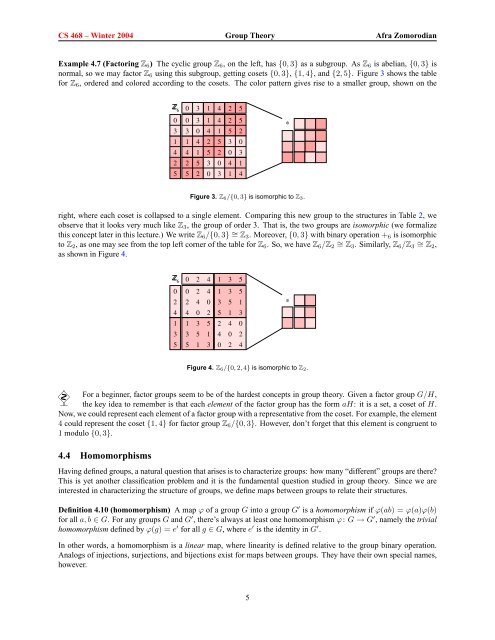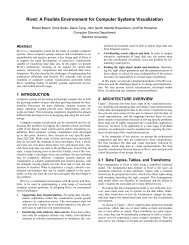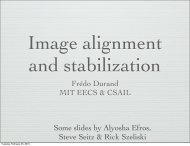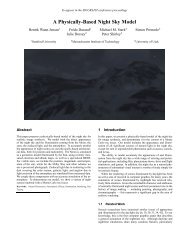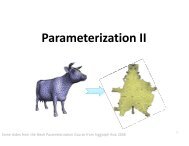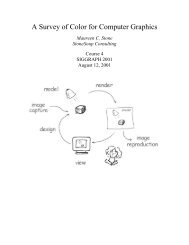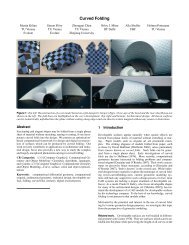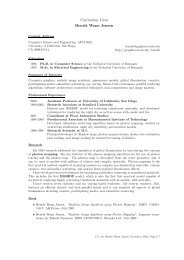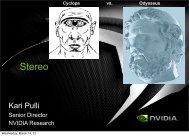Topology for Computing Mini-Kurse pdfsubject - Computer Graphics ...
Topology for Computing Mini-Kurse pdfsubject - Computer Graphics ...
Topology for Computing Mini-Kurse pdfsubject - Computer Graphics ...
Create successful ePaper yourself
Turn your PDF publications into a flip-book with our unique Google optimized e-Paper software.
CS 468 – Winter 2004 Group Theory Afra Zomorodian<br />
Example 4.7 (Factoring Z6) The cyclic group Z6, on the left, has {0, 3} as a subgroup. As Z6 is abelian, {0, 3} is<br />
normal, so we may factor Z6 using this subgroup, getting cosets {0, 3}, {1, 4}, and {2, 5}. Figure 3 shows the table<br />
<strong>for</strong> Z6, ordered and colored according to the cosets. The color pattern gives rise to a smaller group, shown on the<br />
Z 6<br />
0<br />
3<br />
1<br />
4<br />
2<br />
5<br />
0<br />
0 3<br />
3 0<br />
1 4<br />
4 1<br />
2 5<br />
5<br />
3<br />
2<br />
1<br />
1 4 2 5<br />
4 1<br />
2 5<br />
5<br />
4<br />
2<br />
3 0<br />
0 3<br />
2<br />
5<br />
5<br />
2<br />
3 0<br />
0 3<br />
4 1<br />
1 4<br />
Figure 3. Z6/{0, 3} is isomorphic to Z3.<br />
right, where each coset is collapsed to a single element. Comparing this new group to the structures in Table 2, we<br />
observe that it looks very much like Z3, the group of order 3. That is, the two groups are isomorphic (we <strong>for</strong>malize<br />
this concept later in this lecture.) We write Z6/{0, 3} ∼ = Z3. Moreover, {0, 3} with binary operation +6 is isomorphic<br />
to Z2, as one may see from the top left corner of the table <strong>for</strong> Z6. So, we have Z6/Z2 ∼ = Z3. Similarly, Z6/Z3 ∼ = Z2,<br />
as shown in Figure 4.<br />
Z 6 0<br />
0<br />
2<br />
4<br />
1<br />
3<br />
5<br />
2 4<br />
0 2 4<br />
2 4 0<br />
4 0 2<br />
1<br />
3<br />
5<br />
3 5 1<br />
5 1 3<br />
1 3 5<br />
1<br />
3<br />
5<br />
3 5 1<br />
5 1 3<br />
2 4 0<br />
4<br />
0 2<br />
0 2 4<br />
Figure 4. Z6/{0, 2, 4} is isomorphic to Z2.<br />
� For a beginner, factor groups seem to be of the hardest concepts in group theory. Given a factor group G/H,<br />
the key idea to remember is that each element of the factor group has the <strong>for</strong>m aH: it is a set, a coset of H.<br />
Now, we could represent each element of a factor group with a representative from the coset. For example, the element<br />
4 could represent the coset {1, 4} <strong>for</strong> factor group Z6/{0, 3}. However, don’t <strong>for</strong>get that this element is congruent to<br />
1 modulo {0, 3}.<br />
4.4 Homomorphisms<br />
Having defined groups, a natural question that arises is to characterize groups: how many “different” groups are there?<br />
This is yet another classification problem and it is the fundamental question studied in group theory. Since we are<br />
interested in characterizing the structure of groups, we define maps between groups to relate their structures.<br />
Definition 4.10 (homomorphism) A map ϕ of a group G into a group G ′ is a homomorphism if ϕ(ab) = ϕ(a)ϕ(b)<br />
<strong>for</strong> all a, b ∈ G. For any groups G and G ′ , there’s always at least one homomorphism ϕ: G → G ′ , namely the trivial<br />
homomorphism defined by ϕ(g) = e ′ <strong>for</strong> all g ∈ G, where e ′ is the identity in G ′ .<br />
In other words, a homomorphism is a linear map, where linearity is defined relative to the group binary operation.<br />
Analogs of injections, surjections, and bijections exist <strong>for</strong> maps between groups. They have their own special names,<br />
however.<br />
5<br />
*<br />
*


